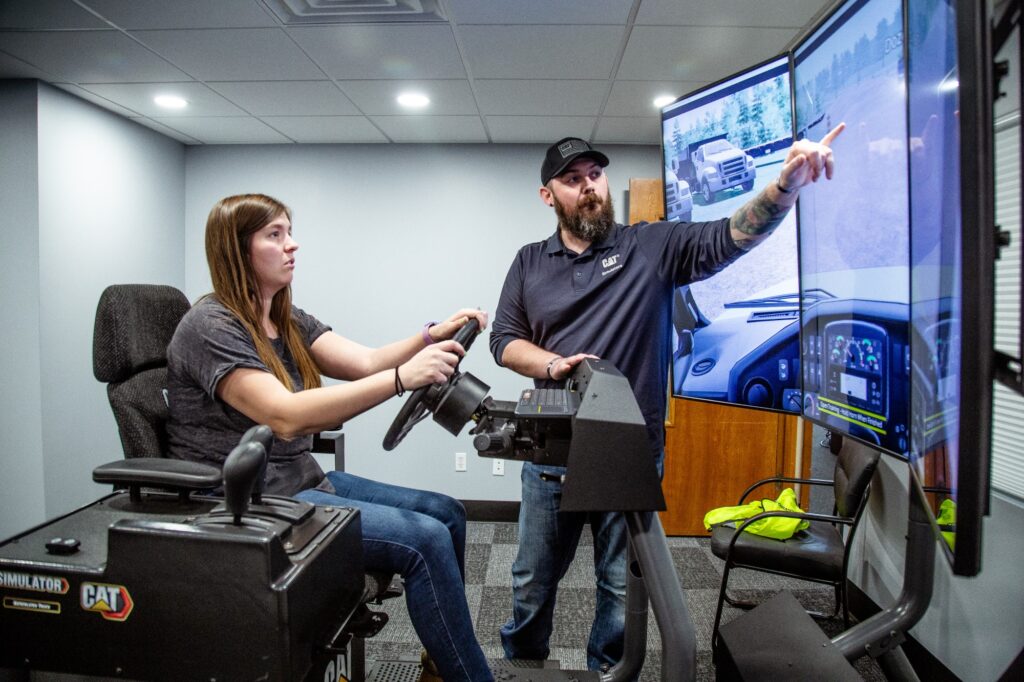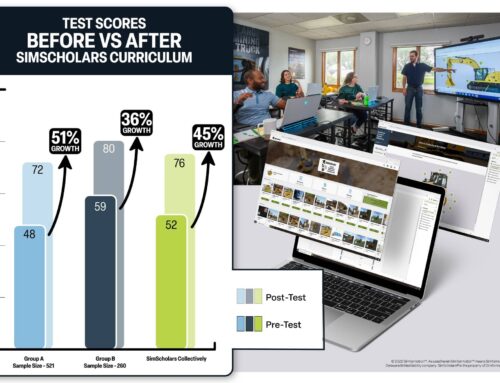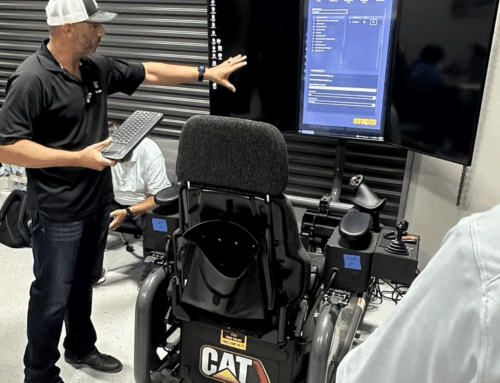When Collins Career Technical Center (CCTC) in Chesapeake, Ohio, launched its adult Heavy Equipment Operator (HEO) training program for adult learners in 2021, the directors wanted it to provide more than just textbooks and in-class instruction. They wanted learners to experience hands-on, in-cab simulator training. That’s when they looked at Cat® Simulators and then incorporated four Cat Simulators systems: the Small Wheel Loader, Motor Grader, Excavator and Dozer into the program.
“We wanted the real-world feel. We wanted the movement in the seat. We wanted the vibrations,” said CCTC’s Associate Director Michael Staton. “We wanted the simulators to just feel as much like sitting in the seat and behind the stick as they possibly could. And that’s what Cat Simulators offer.”

Collaboration with the Industry Leader in Motion Training
To achieve the real-world feel, Cat Simulators collaborated with D-BOX, the industry leader in motion training, to integrate a motion system that replicates the full range of movements and vibrations that operators experience in real machines. The motion system simulates pitch, roll, and heave, along with intelligent vibrations that match the machine’s engine output and terrain interaction.
The motion effects are finely tuned to replicate the machine’s behavior. For instance, when training learners on tasks like navigating slopes or ditches, the motion system replicates the feeling of tipping or shifting weight, giving learners a clear understanding of the machine’s limits and responses before encountering such situations in real life.
Nevada Department of Corrections
Since 2017, the Nevada Department of Corrections (NDOC) has been helping to build the state’s workforce through its vocational program, which includes the Heavy Equipment Operator Apprenticeship Readiness Program. More than 120 students go through the 18-week program each year, which comprises almost 500 hours of training when completed.
“The Cat® Sim program is very immersive—that is the best thing about it. If the simulator doesn’t have the motion platform, it isn’t the same experience. Motion means it feels like you are digging a hole, pushing dirt or picking up a log,” said Michael Budd, Career & Technical Education, Nevada Department of Corrections.

He also believes the familiarization with operator controls and the built-in muscle memory achieved by performing the tasks until productivity levels are met benefit the students. Budd added that the best part of Cat Simulator training is being immersed in the learning environment. “It feels like you are actually operating the equipment on multiple sensory levels and you tend to forget that you are ‘learning’ and focus on the act itself.”
How Does the Motion System Work?
The D-BOX motion system sends signals 60 times per second to ensure precise and up-to-date feedback, providing operators with an experience closely aligned with what they would feel on an actual job site. This accuracy enables trainees to build muscle memory, which is crucial when transitioning from a simulator to a real machine. The motion system also supports incident response training, allowing operators to safely practice handling emergency scenarios like brake failure, which can be challenging to replicate on actual equipment.
The motion system accentuates the training process, as operators can transfer the skills learned on the simulator to actual machinery with greater confidence from having experienced hazardous scenarios on the simulator. Enhanced realism helps operators understand machine operations better and improves situational awareness, resulting in safer and more efficient work environments.
Additionally, using authentic Cat controls ensures that the transition from simulator to real-world machine is seamless, further speeding up the learning curve.
Georgia HEO Pathway Program
Cat Simulators systems are playing a role in connecting students with careers in the construction industry and helping launch students out of generational poverty in the Georgia HEO Pathway Program, according to Jeremy Whitaker, C.W. Matthews Director of Training & Recruitment, who helped develop the Georgia HEO Pathway program.
The HEO program has grown from six original high schools and technical schools to 25 schools located across the state. Whitaker attributes much of the program’s success to the Cat Simulators systems.
“The reason we chose Cat Simulators is because they are the best because of the training modules because of the OEM controls. A student can go directly from the simulator right to the real iron and it’s like they’re putting on a comfortable pair of blue jeans,” said Whitaker. The transition is seamless.”
He added, “After beta testing this program with our own employees, we found that once our employees went from the simulator to the real equipment, they found that the real equipment was easier than the simulator. So from an education standpoint, you can’t ask for anything more than that, that really prepares them for the real iron that we need to build the roads for tomorrow.”







